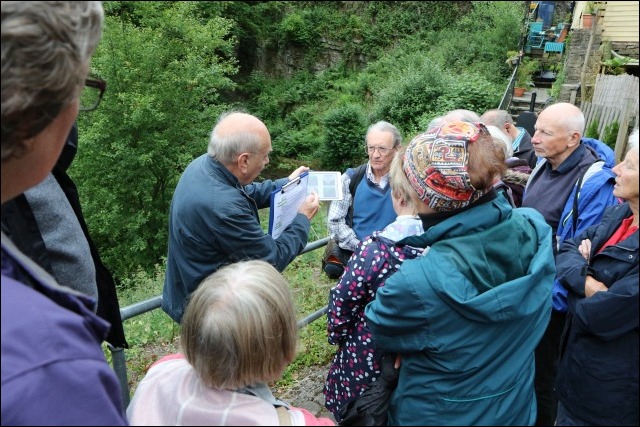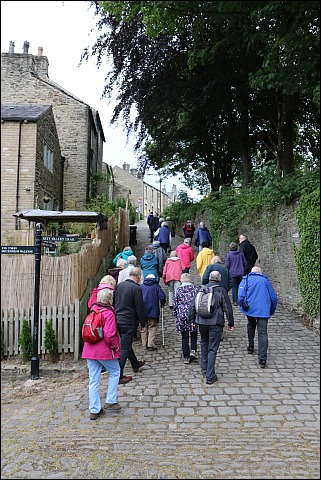
“No Torrs on this tour " was the promise of this evening. Apparently there was a rival attraction in Russia, of all places but we were historians, not football fans. We swept through a near-deserted New Mills, covering 25,000 years of history in two hours of enlightenment. And Neil kept to his promise about the Torrs though we still had some steep hills to climb.
His preamble covered the theme of the evening – a town that emerged from obscurity to become an important cotton town despite a number of handicaps. This involved a move away from a textile-based description of the town's history to one encompassing many aspects, - communications, housing, religion and drinking.
 Setting off on a circuit of the town, Neil put to full use the twelve stops, twelve stations of information that he had designed. One aspect of this, and some other recent walks, has been the introduction of tablets to display images to accompany the spoken world. This adds a lot to the understanding of the evening. Thanks, on this occasion, must go to David Burridge and Neil for their work on this facility, and to those who brought along their electronic gizmos, loaded with images.
Setting off on a circuit of the town, Neil put to full use the twelve stops, twelve stations of information that he had designed. One aspect of this, and some other recent walks, has been the introduction of tablets to display images to accompany the spoken world. This adds a lot to the understanding of the evening. Thanks, on this occasion, must go to David Burridge and Neil for their work on this facility, and to those who brought along their electronic gizmos, loaded with images.
Neil began his sweep through 25,000 years of the area’s history, whilst standing on the site of the chain horse stable overlooking the Torrs. How the Ice Age formed the deep ravines and altered the course of the River Goyt. This created a formidable barrier to communications in the vicinity until virtually the end of the nineteenth century. During the Middle Ages New Mills formed an insignificant location on the edge of the Royal Forest of the Peak. Hayfield and Mellor were the major settlements; New Mills existed uncomfortably between them.
Transport and the isolation of New Mills formed the discussion at the Bus Station, fortuitously illustrated by the arrival of the 358 bus. Turnpikes and railways gradually ended the isolation during the 19th century, with the Union Bridge finally joining Newtown and New Mills, opening in 1884. It was surely serendipity that the native rock in the Torrs was ideal for building bridges.
Wandering down Market Street, the res olute pedestrian explorers ignored the big screens and the England match glimpsed through the windows of the Royal Oak and arrived in Meal Street. Standing on this cobbled street Neil discussed the terraced housing built on steep slopes, with ‘underlivings’. This was dwellings built on steep slopes where there were two or three storeys on the higher street but perhaps four or five storeys visible on the lower street. Several families lived in these houses at different levels. Looking over the wall, on our right, we could see the remains of one of the mills that stood in the valley, nestling on ledges - Hyde Bank, Rock, Torr, Grove, and Torr Vale Mills. By 1810 there were 9 spinning mills 3 weaving mills and 3 printworks in New Mills. It is a suggestion of Neil’s that John Potts contribution to textiles is overlooked. John Potts (1791–1841) was the inventor of a method of calico printing by the use of copper rollers onto which patterns had been engraved, overcoming the problems associated with single block printing.
olute pedestrian explorers ignored the big screens and the England match glimpsed through the windows of the Royal Oak and arrived in Meal Street. Standing on this cobbled street Neil discussed the terraced housing built on steep slopes, with ‘underlivings’. This was dwellings built on steep slopes where there were two or three storeys on the higher street but perhaps four or five storeys visible on the lower street. Several families lived in these houses at different levels. Looking over the wall, on our right, we could see the remains of one of the mills that stood in the valley, nestling on ledges - Hyde Bank, Rock, Torr, Grove, and Torr Vale Mills. By 1810 there were 9 spinning mills 3 weaving mills and 3 printworks in New Mills. It is a suggestion of Neil’s that John Potts contribution to textiles is overlooked. John Potts (1791–1841) was the inventor of a method of calico printing by the use of copper rollers onto which patterns had been engraved, overcoming the problems associated with single block printing.
Moving to High Street, both religious and alcoholic history are evident in the form of the Revive Church, originally a Wesleyan Chapel dating back to 1766, and the Masons' Arms, a coach terminus in the 1820s for the ’Mercury Coach’ to Manchester. Here, too, stood tightly packed cottages, most demolished pre-1939.
Continuing through the somewhat deserted streets, with the dying light of a day three days before Summer Solstice, we walk on a route through Dye House Lane, Spring Bank, and the High Street. En-route we pass and view, the Woodside Garage, in a former life the Salem Mill, and next to it the site of the original “new mill” rebuilt in 1391. Other points of interest were 117 Dye House Lane - the site of the old police cell, Almhouses, Spring Bank Board School and the Mackie Library.
It is agreed that the Town Hall, on Spring Bank, is a fine building for such a comparatively small town. Finished in 1871, with the tower added in 1875, money was collected over twelve years for its construction. To the side of the Town Hall is the former Police Station, famous for holding the arrested trespassers from the Kinder Trespass of 1932.
Reaching the conclusion of the stroll we stand before a rather sorry looking Telephone Box. Neil now reveals a nugget of information, worthy of any pub quiz, that Sir Giles Gilbert Scott’s competition winning design, was based on Sir John Soane Mausoleum.
To reach the car park again two routes are on offer, the gentle stroll or the neo-vertical ginnel of steps and steep slopes – what an adventure!!
Reaching the car park, Neil was thanked for his efforts. Not just for the entertaining evening but also for the research that had gone into making it so interesting.
Neil donated the money he received to Christies.
Photos: David Burridge
Text: Martin Cruickshank
Further reading: New Mills Conservation Area Character Appraisal
Two videos, below gallery
Drone Commercial Footage Swizzels Matlow Ltd Mill Factory
Drone Flight Millennium Walkway, New Mills
















